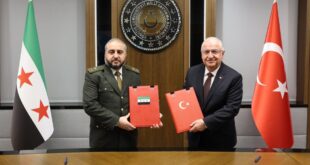SRIFA — Every window in Srifa’s main school has been blown out by Israeli bombs.
Lego bricks, coloured crayons and shards of glass are scattered across the floor of the nursery. Toddler-sized wooden chairs and desks are covered in debris and dust.
Upstairs, the buckled walls of the science laboratory are on the verge of collapse. Books, papers and children’s drawings litter the floor of the library.
“It makes me so sad to see the place like this,” says headmaster Mohammad Nazzal as he picks through the rubble of a building in which he has worked for 36 years. “At least two Israeli bombs landed on the building next door. We didn’t take a direct hit, but the damage is bad.” Srifa Mixed Public School is one of up to 350 in southern Lebanon which, according to the education ministry, were destroyed or seriously damaged by Israeli bombing during the war with Hizbollah fighters. In damaging schools, the Israelis struck a blow at Lebanon’s future as well as its present, the government says. The ministry puts the cost of the war to the education sector at $90 million in damaged infrastructure, equipment and supplies, and has postponed the start of the academic year by a month to give schools time to recover. Many will still not be ready in time, and thousands of children, like 14-year-old Hassan Ajami, will start the school year in makeshift classrooms.”When the war started we left for the Shouf Mountains,” Ajami said as he stood outside Srifa’s school gates. “When we came back I was so surprised. Why did they hit it? What is it that makes this building a target?” Down the road at the town hall, Mayor Afif Najdi offers a bleak assessment for the school year now due to start on Oct. 18. “Many kids will simply not go to school,” he says. “They have no alternative.”
Schools played a vital role during the 34-day war.
According to the UN children’s agency UNICEF, some 150,000 refugees took refuge in them in Beirut and other parts of Lebanon after fleeing their homes in the south.
Since the end of the conflict, some southern schools have acted as community centres to help those returning to their rubble-strewn towns and villages. Headmaster Nazzal says he believes the Israeli jets aimed at Srifa school but failed to land a direct hit, but Israel’s army says preliminary checks show it did not target a single school directly. It has, however, repeatedly accused Hizbollah fighters of using civilian structures as cover and for storing weapons, and viewed them as legitimate targets during the conflict. David Gorali, a spokesman for Israel’s education ministry, said 32 schools in northern Israel were damaged by Hizbollah rockets during the fighting.
“Two of the schools — one of them a special education institution — sustained heavy damage,” he said.
Help for Lebanon’s schools is on its way, much of it from Gulf states which have offered to pay for the renewal of the education sector in the south. UNICEF is putting together packs of equipment, including blackboards, chalk, exercise books, pens and pencils, and plans to distribute them to 1,500 Lebanese state schools. It also hopes to hand out school bags containing basic equipment to 350,000 children, but only when it knows if and when they will have classrooms to go to. “The delay to the start of the school year gives us some flexibility, but it will still require a major effort on the part of a whole range of powers to ensure these children have some form of education once the new year starts,” UNICEF spokesman Simon Ingram said.
 Eurasia Press & News
Eurasia Press & News



